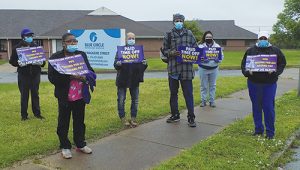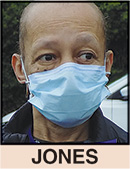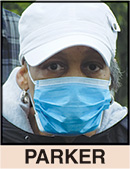By TIM ROWDEN
Editor

St. Louis – Workers from Blue Circle Nursing & Rehab, where eight residents are suspected to have lost their lives to COVID-19 and another dozen are in quarantine, demonstrated outside the home last week to demand paid sick-time for coworkers who have been exposed and infected, and to call for hazard pay for the duration of the coronavirus pandemic.
“We’re not sure all the deaths are COVID-related, but we suspect they are,” said Laura Barrett, Missouri campaign coordinator for SEIU Healthcare, which represents workers at the home.
“The issue for us is, our members are not getting paid time-off , they’re not getting the 80 hours that the federal government says they can.”
The Families First Coronavirus Response Act (FFCRA or Act) requires certain employers to provide employees with two weeks (up to 80 hours) of paid sick leave at the employee’s regular rate of pay if the employee is unable to work because they are quarantined or experiencing COVID-19 symptoms and seeking a medical diagnosis.
That’s not the case at Blue Circle though.
Nursing home workers are risking their own health and safety serving residents on the frontlines across the St. Louis region, but employers have been slow to secure adequate PPE and continue to ignore demands for resources and policies needed to keep the workforce and residents safe.
 ‘I’M SO SCARED’
‘I’M SO SCARED’
Nedra Jones has worked as a Certified Nursing Assistant (CNA) at Blue Circle since 2004, but has been off without pay since COVID-19 cases started appearing at the facility. She doesn’t know for certain if she’s been in contact with COVID-19 patients, but assumes she has since cases started popping up in the facility.
“I’m so scared working up in here,” she said “I take care of my mother, and I have grandkids. I don’t want to give her anything, or give my grandkids anything. If we can’t keep the patients safe, we can’t keep ourselves safe. We have people out because of COVID right now, and they’re not getting paid. They don’t even call us to see how we’re doing. I call here every day to check on my residents. We are very passionate with these residents, and it hurts me every day not to be here with them.”
 Nodie Parker, a housekeeper at Blue Circle, says administrators aren’t doing enough to protect staff or keep them informed.
Nodie Parker, a housekeeper at Blue Circle, says administrators aren’t doing enough to protect staff or keep them informed.
“We’re hearing about people that have caught it, but we don’t exactly know it,” she said. “They’re not giving us enough information.
“I feel I need more money coming here every day,” she said. “We would be here anyway because we care about our residents. But they’re not offering us anything.”
 ‘WE’RE THE FIRST CONTACT’
‘WE’RE THE FIRST CONTACT’
“We love the facility and we love the residents here,” housekeeper Lemarr Young said. I’ve been here 20 years. We’re taking the risk because we’re the first contact against this. We’re here every day making sure this place is spic-and-span.
“We’re going to take care of these people regardless. But in this type of situation, it’s totally different. We’re not asking anything outrageous. We’re just asking to be treated fairly.”
U.S. Department of Labor issues alert to keep nursing home,
long-term care facility workers safe during pandemic
Washington – The U.S. Department of Labor’s Occupational Safety and Health Administration (OSHA) issued an alert last week outlining safety measures employers should implement to protect workers at nursing home and long-term care from exposure to the coronavirus:
• Screen workers and residents regularly for signs and symptoms consistent with the coronavirus. Send sick workers home or to seek medical care.
• Closely monitor and take additional precautions regarding employees and residents who may have been exposed to an individual with the coronavirus.
• Ask visitors to inform the facility if they develop a fever or symptoms consistent with the coronavirus within 14 days of their visit.
• Maintain at least six feet between workers, residents, and visitors to the extent possible, including while workers perform their duties and during breaks.
• Stagger break periods to avoid crowding in breakrooms.
• Consider alternatives to in-person large group gatherings (e.g., staff meetings, resident activities).
• Continually monitor personal protective equipment (PPE) stocks, burn rate, and supply chains. Develop a process to decontaminate and reuse PPE, such as face shields and goggles, as appropriate. Follow CDC recommendations for optimization of PPE supplies (cdc.gov/coronavirus/2019-ncov/hcp/ppe-strategy/index.html).
• Encourage workers to report any safety and health concerns.
FOR MORE INFORMATION
Visit OSHA’s Publications webpage for other useful workplace safety information at osha.gov/pls/publications/publication.html.
OSHA has also published a Guidance on Preparing Workplaces for COVID-19 at osha.gov/Publications/OSHA3990.pdf to help workers and employers learn about ways to protect themselves and their workplaces during the ongoing pandemic.
Visit OSHA’s coronavirus webpage at osha.gov/SLTC/covid-19 for updates.
For more information about coronavirus, visit the Centers for Disease Control and Prevention at cdc.gov/coronavirus/2019-ncov.

